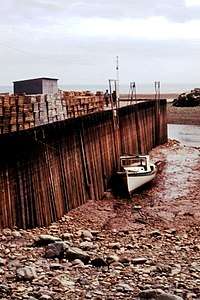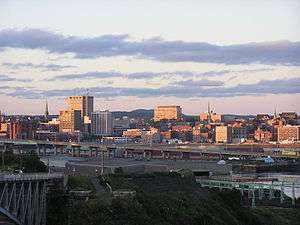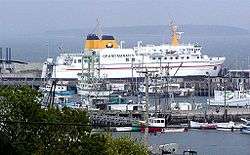Bay of Fundy
The Bay of Fundy (French: Baie de Fundy) is a bay between the Canadian provinces of New Brunswick and Nova Scotia, with a small portion touching the US state of Maine. It has an extremely high tidal range. The name is likely a corruption of the French word Fendu, meaning "split".[1]
| Bay of Fundy | |
|---|---|
| Baie de Fundy | |
 The Bay of Fundy | |
| Location | New Brunswick, Nova Scotia, Maine |
| Coordinates | 45°00′N 65°45′W |
| Type | Estuary |
| Etymology | Likely from the French Fendu, meaning "split". |
| River sources | Big Salmon, Magaguadavic, Memramcook, Petitcodiac, Quiddy, Saint John, St. Croix, Upper Salmon, Annapolis, Avon, Cornwallis, Farrells, Salmon, Shubenacadie, Kennetcook |
| Primary outflows | Gulf of Maine |
Hydrology


Tides
The tidal range in the Bay of Fundy is about 13 metres (43 ft). (The average tidal range worldwide is about one metre (3 ft 3 in).) Some tides are higher than others, depending on the position of the moon, the sun, and atmospheric conditions.[2] Tides are semidiurnal, meaning they have two highs and two lows each day[2] with about six hours and 13 minutes between each high and low tide.[2]
Because of tidal resonance in the funnel-shaped bay, the tides that flow through the channel are very powerful. In one 12-hour tidal cycle, about 100 billion tonnes (110,000,000,000 short tons) of water flows in and out of the bay, which is twice as much as the combined total flow of all the rivers of the world over the same period.[3] They are as powerful as 8,000 train engines or 25 million horses.[4] The Annapolis Royal Generating Station, a 20 MW tidal power station on the Annapolis River upstream of Annapolis Royal, is one of the few tidal generating stations in the world, and the only one in North America.[5]
Most of the rivers have a tidal bore, a wave front of the incoming tide that "bores" its way up a river against its normal flow. Notable ones include those on the Petticodiac, Maccan, St. Croix, and Kennetcook rivers.[6] Before the construction of a causeway in 1968 and subsequent siltation of the river, the Petitcodiac River had one of the world's largest tidal bores, up to 2 metres (6.6 ft) high. Since the opening of the causeway gates in 2010, the bore has been coming back, and in 2013 surfers rode it a record-breaking 29 kilometres (18 mi).[7]
Other phenomena include the Reversing Falls near the mouth of the Saint John River, a rip tide at Cape Enrage, and the Old Sow whirlpool at Passamaquoddy Bay.[6]
Geology
The story of the Fundy Basin begins about 200 million years ago in the early Jurassic, when all land on earth was part of a supercontinent called Pangaea. At that time what is now The Maritimes was situated near the equator and had a warm tropical climate and lush vegetation.[8] As continental drift reshaped the world, rift valleys formed, including the Cobequid-Chedabucto fault system.
During the continental breakup, magma erupted as basaltic lavas and left igneous rock formations such as the columnar jointing which can be seen on Brier and Grand Manan islands, among other places around the bay. These flows often are the sites of rarer mineral deposits including agate, amethyst, and stilbite, the latter being the provincial mineral of Nova Scotia.[8]
These rifts filled with sediment which became sedimentary rock. Many fossils have been found along the Fundy shoreline. The oldest dinosaur fossil in Canada was found at Burntcoat Head. Very early reptiles have been discovered in Carboniferous tree trunks at Joggins. Wasson Bluff has a rich trove of Jurassic fossils.
The bay is a member of the Global Geoparks Network,[9] a UNESCO initiative to promote and conserve the planet's geological heritage.
Flora and fauna
Although some land areas are protected, there is no formal marine protection zone in the bay,[10] but the Conservation Council of New Brunswick is working to protect the ecosystem of the bay.[11] The endangered North Atlantic right whale can be seen in the bay.[12] A result of shipping traffic has been the potential for increased collisions between ships and the extremely endangered North Atlantic right whale. In 2003, the Canadian Coast Guard adjusted shipping lanes crossing prime whale feeding areas at the entrance to the Bay of Fundy to lessen the risk of collision. Many other marine mammals are found in the bay including fin whales, humpback whales, minke whales, Atlantic white-sided dolphin and the harbour porpoise.
The Bay of Fundy mudflats are a rare and unique intertidal habitat. Major mudflats are found on around the Maringouin Peninsula which lies between Shepody Bay and the Cumberland Basin and at the northern end of Chignecto Bay. On the Nova Scotia side mudflats are found on the southern side of the Minas Basin and in Cobequid Bay. In the Minas Basin, the size of the mudflats from low water to high water marks is as much as 4 km (2.5 mi).[13] Due to tidal turbulence, the water in these area contains very high amounts of fine sediment, source from tidal erosion of Carboniferous and Triassic sedimentary rock. Primary producers include hollow green weed, phytoplankton, algae, and sea lettuce.
Protected areas include:
- Boot Island National Wildlife Area in the Minas Basin near the mouth of the Gaspereau River.[14]
- Chignecto National Wildlife Area: near Amherst, contains a wide variety of habitats due to its geology.[15]
- Grindstone Island Conservation Easement: managed by the Nature Trust of New Brunswick through a conservation easement on an island at the entrance of Shepody Bay.[16]
- Isle Haute, managed by the Canadian Wildlife Service.[17]
- John Lusby Marsh National Wildlife Area: a large wetland system near Amherst.[18]
- Raven Head Wilderness Area, protects 44 km (27 mi) of undeveloped coast along the bay. It is southwest of Joggins and also a site for fossils. It is also a wildlife habitat for endangered species.[19]
- Shepody National Wildlife Area: a habitat for birds and other wildlife,[20] recognized as an important wetland under the Ramsar Convention, a site of importance by the Western Hemisphere Shorebird Reserve Network, and a bird area by BirdLife International. The dominant bird species is the semipalmated sandpiper.
- South Wolf Island Nature Preserve: in the lower bay, about 12 km (7.5 mi) offshore from Blacks Harbour. It was donated to the Nature Trust of New Brunswick by Clover Leaf Seafoods in 2011. It is ecologically important for birds, some not common on the mainland, as well as some very rare plants.[12]
- Tintamarre National Wildlife Area[21]
Human geography and history
History
The Mi'kmaq fished in the Bay of Fundy and lived in communities around the bay for centuries before the first Europeans arrived. According to Mi'kmaq legend, the tide was created when Glooscap wanted to take a bath.[22]
The first European to visit the bay may have been Portuguese explorer João Álvares Fagundes in about 1520, although the bay does not appear on Portuguese maps until 1558.[23] The first European settlement was French, founded at Saint Croix Island in Maine, and then Port Royal, founded by Pierre Dugua and Samuel de Champlain in 1605. Champlain named it Labaye Francoise[24][25] (The French Bay). Champlain describes finding an old rotted cross in the bay which may have been left by the Portuguese.[23]
The village was the first permanent European settlement north of the Spanish St. Augustine, Florida, and predated by two years the first permanent British settlement in Jamestown, Virginia. About 75 years later, Acadians spread out along the bay, founding Grand-Pré, Beaubassin, Cobequid, and Pisiguit.[26]
There was much military action and many attacks on the settlements around the bay, first as the French and British fought for control of the area, leading to the Expulsion of the Acadians, and later by Americans during the American Revolution and the War of 1812.[27]
In the 19th century, the bay was the site of much shipping, and shipbuilders flourished, including James Moran of St. Martins, New Brunswick, Joseph Salter, of Moncton, and William D. Lawrence of Maitland, Nova Scotia. Fundy ports produced the fastest ship in the world, Marco Polo; the largest wooden ship ever built in Canada, William D. Lawrence; and the first female sea captain in the western world, Molly Kool. The mystery ship Mary Celeste was also built there.
The highest water level ever recorded, 21.6 metres (71 feet), occurred in October 1869. It caused extensive destruction to ports and communities, much of which was attributed to a two-metre storm surge created by the Saxby Gale, a tropical cyclone, which coincided with a perigean spring tide. Waves breached dykes protecting low-lying farmland in the Minas Basin and the Tantramar Marshes, sending ocean waters surging far inland.
Settlements
The largest population centre on the bay is Saint John, New Brunswick, a major port[28] and Canada's oldest city.[29] Other settlements include, in New Brunswick, St. Andrews, Blacks Harbour, St. Martins and Sackville, and in Nova Scotia, Amherst, Parrsboro, Truro, Windsor, Wolfville, Annapolis Royal, and Digby.

Ports and shipping

The port of Saint John gives access to the pulp and paper industry and the Irving oil refinery. Hantsport, Nova Scotia, also has a pulp and paper mill and ships gypsum to the United States.
The bay is also traversed by ferries:
- Saint John to Digby, operated by Bay Ferries.
- Grand Manan to Blacks Harbour and White Head Island, to Grand Manan, operated by Coastal Transport.
- The Letete to Deer Island Ferry, operated by the New Brunswick Department of Transportation.
- Campobello Island, to Deer Island and Eastport, Maine, to Deer Island. Operated by East Coast Ferries Limited.
- Brier Island to Long Island and Long Island to peninsular Nova Scotia, operated by Nova Scotia Department of Transportation and Public Works.
Gallery
.jpg) Tilted layers of sandstone at Hopewell Rocks
Tilted layers of sandstone at Hopewell Rocks- The Minas Basin in early May
 Reversing Falls is where the Saint John River and Bay of Fundy meet.
Reversing Falls is where the Saint John River and Bay of Fundy meet. Salmon River tidal bore
Salmon River tidal bore- Basal contact of a lava flow section of Fundy basin
References
- Garrett, Chris; Koslow, Tony; Singh, Rabindra (March 25, 2015) [July 8, 2010]. "Fundy, Bay of and Gulf of Maine". The Canadian Encyclopedia (online ed.). Historica Canada.
- "The Bay of Fundy is a 160 billion tonne wonder. Here's why". Tourism New Brunswick. Government of New Brunswick. 2018-05-02. Retrieved 7 June 2019.
- "Why are the Bay of Fundy Hides so High?". www.bayfundy.net. Retrieved 15 June 2019.
- "Bay of Fundy Tides". bayoffundy.com. Retrieved December 19, 2019.
- "Annapolis Tidal Station". Nova Scotia Power. Archived from the original on 1 July 2019. Retrieved 1 July 2019.
- "The tidal bore". Bay of Fundy. Retrieved 15 June 2019.
- "Surfers set record after 29 km ride on Moncton tidal bore". CBC. Retrieved 18 June 2019.
- Atlantic Geoscience Society (2001). The Last Billion Years: a Geological History of the Maritime Provinces of Canada. Nimbus Pub. pp. 126–134. ISBN 1-55109-351-0.
- "UNESCO Global Geoparks – Cliffs of Fundy Aspiring Global Geopark – Tidal Landscapes on an Ancient Shoreline". Cliffs of Fundy aspiring Geopark. Retrieved 15 June 2019.
- "FAQ". Canadian Parks and Wilderness Society. Retrieved 19 June 2019.
- "Marine Conservation". Conservation Council of New Brunswick. 2013-02-17. Retrieved 21 June 2019.
- "South Wolf Island Nature Preserve". Nature Trust of New Brunswick. Retrieved 19 June 2019.
- "Bay of Funday Mudflats". Fundy Biosphere. Retrieved 20 June 2019.
- "Boot Island National Wildlife Area". Government of Canada. 2011-12-21. Retrieved 20 June 2019.
- "Chignecto National Wildlife Area". Government of Canada. 2011-12-21. Retrieved 20 June 2019.
- "Grindstone Island Conservation Easement". Nature Trust of New Brunswick. Retrieved 19 June 2019.
- "Isle Haute National Wildlife Area". Government of Canada. 23 April 2019. Retrieved 19 June 2019.
- "John Lusby Marsh National Wildlife Area". Government of Canada. 2011-12-21. Retrieved 20 June 2019.
- "Raven Head Wilderness Area". Government of Nova Scotia. 1 April 2009. Retrieved 19 June 2019.
- "Shepody National Wildlife Area". Government of Canada. 2011-12-21. Retrieved 20 June 2019.
- "Tintamarre National Wildlife Area". Government of Canada. 2011-12-21. Retrieved 20 June 2019.
- "Mi'kmaq Heritage". Bay of Fundy. 1 February 2011. Retrieved 15 June 2019.
- "European Contact and Mapping". Mount Allison University. Retrieved 23 July 2019.
- Map of the northeast coast of North America, 1607, drawn by Samuel de Champlain, umaine.edu
- Champlain's 1607 Map of New England, old-maps.com
- Faragher, John Mack (2005). A Great and Noble Scheme: The Tragic Story of the Expulsion of the French Acadians from Their American Homeland. W.W Norton & Company. pp. 110–112. ISBN 978-0-393-05135-3.
- Smith, Joshua (2011). Battle for the Bay: The Naval War of 1812. Fredericton, NB: Goose Lane Editions. pp. passim. ISBN 978-0-86492-644-9.
- "Port Saint John reports 2016 tonnage". Archived from the original on July 28, 2017. Retrieved July 23, 2017.
- "Saint John". Canadian Encyclopedia. Retrieved June 12, 2017.
See also
- Military action in the bay: Raid on St. John (1775), Battle off Cape Split, Raid on Annapolis Royal (1781).
- Fundy National Park, which connects to the Fundy Footpath.
- The Rocks Provincial Park, site of the Hopewell Rocks
- Cape Chignecto Provincial Park: Nova Scotia's largest provincial park, named for Cape Chignecto, a headland which divides the Bay of Fundy and Chignecto Bay to the north and the Minas Channel leading to the Minas Basin to the east.
- Blomidon Provincial Park and Five Islands Provincial Park, both in Nova Scotia.
- Roosevelt Campobello International Park: preserves the house and surrounding landscape of the summer retreat of Franklin D. Roosevelt, on Campobello Island in New Brunswick.[1]
External links
| Wikimedia Commons has media related to Bay of Fundy. |
| Wikivoyage has a travel guide for Bay of Fundy. |
| Wikisource has the text of the 1911 Encyclopædia Britannica article Fundy, Bay of. |
- Where the Bay Becomes the Sea: a documentary about the Bay of Fundy ecosystem
- Bay of Fundy Ecosystem Partnership: scientific and popular information about the Bay.
- "Welcome to Campobello Island". VisitCampobello.com. Retrieved 21 June 2019.